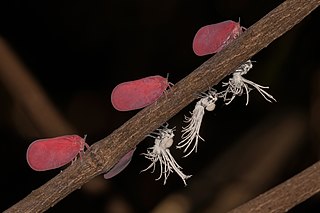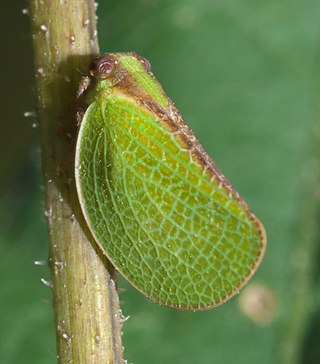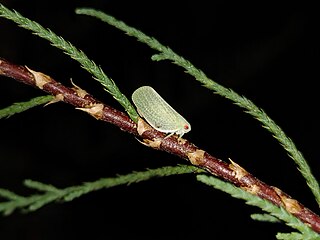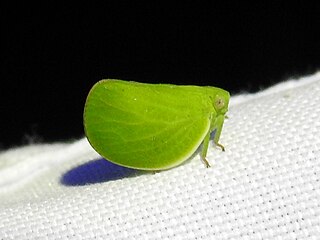
The Auchenorrhyncha suborder of the Hemiptera contains most of the familiar members of what was called the "Homoptera" – groups such as cicadas, leafhoppers, treehoppers, planthoppers, and spittlebugs. The aphids and scale insects are the other well-known "Homoptera", and they are in the suborder Sternorrhyncha.

A planthopper is any insect in the infraorder Fulgoromorpha, in the suborder Auchenorrhyncha, a group exceeding 12,500 described species worldwide. The name comes from their remarkable resemblance to leaves and other plants of their environment and that they often "hop" for quick transportation in a similar way to that of grasshoppers. However, planthoppers generally walk very slowly. Distributed worldwide, all members of this group are plant-feeders, though few are considered pests. The infraorder contains only a single superfamily, Fulgoroidea. Fulgoroids are most reliably distinguished from the other Auchenorrhyncha by two features; the bifurcate (Y-shaped) anal vein in the forewing, and the thickened, three-segmented antennae, with a generally round or egg-shaped second segment (pedicel) that bears a fine filamentous arista.

Acanalonia is a genus of planthopper in the fulgorid family Acanaloniidae.
Oryxa is a genus of planthoppers in the hemipteran family Flatidae. They live on the islands of Borneo and Sumatra, and in Malaysia.

Aplos is a genus of issid planthopper with only one species, Aplos simplex. It can be found in most of the Eastern United States and is now found as an invasive species in Northern Italy and Austria. Aplos simplex was formerly listed under the genus Thionia.

Acanaloniidae is a family of planthoppers. It is sometimes treated as a subfamily of Issidae.

Acanalonia conica is a species of acanaloniid planthopper in the family Acanaloniidae. It is found in North America and Europe.

Acanalonia bivittata, the two-striped planthopper, is a species of planthopper in the family Acanaloniidae, and the most common and widespread member of the genus Acanalonia. Adults of this species are typically green, though occasionally pink. There is a reddish stripe on the inner edge of the wing.
Aylaella is a genus of planthoppers belonging to the family Acanaloniidae.

Picumna is a genus of planthopper in the family Issidae. They can be found in the Southwestern United States and Central America. Picumna species are often confused with Thionia species, but can be differentiated as Picumna have four spines on their hind tibia, whereas Thionia have fewer.

Picumna chinai is a species of planthopper in the family Issidae. They can be found across the Southwestern United States and Central America.

Abolloptera is a genus of planthoppers with only one species, Abolloptera bistriata. It is found in Texas and north-eastern Mexico.

Acanalonia servillei is a species of planthopper in the family Acanaloniidae. It is a widely distributed species, being found along the East Coast and Gulf Coast of the United States as far southwest as Texas and as far north as New York. It is also found on many Caribbean islands such as The Bahamas, Cuba, Hispaniola, and Jamacia. Like most planthoppers, it feeds on the sap of plants. It is noted as being associated with Capparis cynophallophora along with other plants in the caper family, though not exclusively. It is a quite large species for its family, usually measuring more than 9mm.

Acanalonia chloris is a species of planthopper in the family Acanaloniidae. It can be found in northern Argentina, Chile, and Uruguay.

Acanalonia fasciata is a species of planthopper in the family Acanaloniidae. It can be found in the Southwestern United States and northwestern Mexico. Possible predators include several local species of dryinid wasp. It is a smaller species with a length varying from 4.2 to 6.2 mm. It is often confused with Acanalonia bivittata, but can be differentiated by its smaller size, lack of reticulation on the base of its elytra, and by its range being farther west.

Acanalonia clypeata is a species of planthopper in the family Acanaloniidae. It can be found in the Southwestern United States. It can be found feeding on many plants including but not limited to tumbleweed, four-wing saltbush, baccharises, and Prosopis. It is approximately 7 mm long and 3 mm wide.

Acanalonia virescens is a species of planthopper in the family Acanaloniidae. It is found in coastal regions such as southern coastal Texas, the east cost of Mexico, and as far south as Panama. It was initially recorded in Florida, but has not been found there since.

Acanalonia excavata is a species of planthopper in the family Acanaloniidae. It is native to Nicaragua and is adventive in Florida. It is about 9 mm long.

Acanalonia invenusta is a species of planthopper in the family Acanaloniidae. It is found in New Mexico, Texas, and northern Mexico. It is quite visually similar to Acanalonia similis, though the two can be differentiated by A. invenusta having less prominent reticulation across its elytra. It measures 4.2 - 5.6 mm.

Acanalonia similis is a species of planthopper in the family Acanaloniidae. It is found in Texas, New Mexico, and Arizona. It is quite visually similar to Acanalonia invenusta, but though the two can be differentiated as A. similis has more prominent reticulation across its elytra than A. invenusta. A. similis measures 4.2 - 4.9 mm long.

















